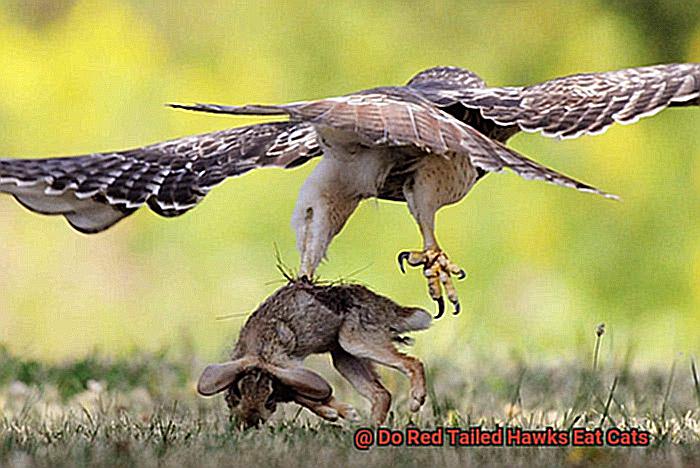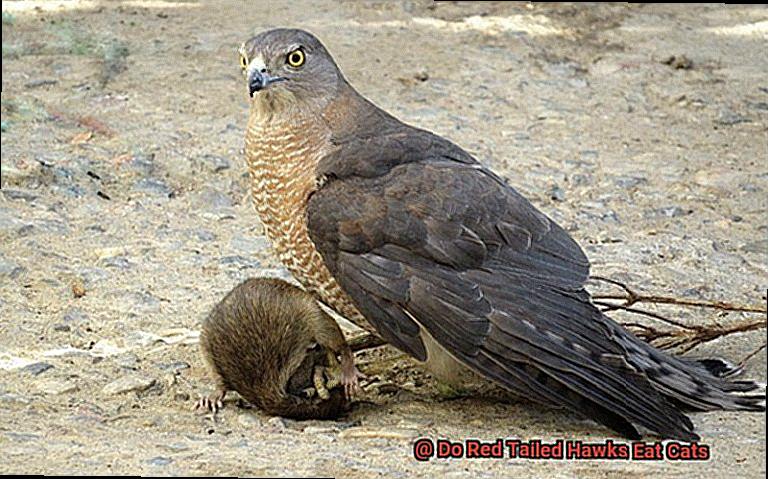As we gaze up at the soaring silhouette of a red-tailed hawk, it’s hard not to be captivated by their grace and power. These impressive birds are a common sight in many parts of North America, with their striking reddish-brown tails blazing like beacons against the sky. But as much as we admire their beauty, there’s one question that often comes to mind: do red-tailed hawks eat cats?
While these raptors are known for their prowess as hunters, it’s important to separate fact from fiction when it comes to this topic. Yes, some people claim to have seen red-tailed hawks snatching up unsuspecting felines. But the truth is that such occurrences are extremely rare.
Rodents, rabbits, and other small animals make up the bulk of a red-tailed hawk’s diet. Cats, on the other hand, are not a natural part of their menu. In fact, these birds would typically avoid going after such large and powerful prey.
That being said, there are situations in which cats might be vulnerable to attack by red-tailed hawks. For instance, an injured or sick cat might seem like an easy target for a hungry bird. And unattended kittens could also be at risk if they wander too far from home.
So while the answer to whether red-tailed hawks eat cats is mostly “no”, it’s still important to take precautions and keep your pets safe. If you live in an area where these birds are common, make sure your cats stay indoors or supervised when outside.
In our next installment on this fascinating topic, we’ll explore more about the complex relationship between birds of prey and our beloved feline friends. So stay tuned.
What are Red-Tailed Hawks?
These magnificent birds of prey are a common sight in North America and are known for their striking appearance, powerful hunting skills, and impressive physical characteristics.
Red-Tailed Hawks are opportunistic hunters with keen eyesight and agility in flight. They primarily prey on small mammals such as rodents, rabbits, and squirrels, but they have been known to target birds, reptiles, and even insects. With their broad wingspan and sharp talons, these hawks are formidable predators that play an important role in the ecosystem.

One question that often arises is whether Red-Tailed Hawks pose a threat to domestic cats. While it is true that hawks may occasionally target cats, the risk of such an attack is relatively low. Outdoor cats that roam unsupervised are at a higher risk of being targeted, but cat owners can take simple steps to reduce this risk by keeping their pets indoors or supervised when outside, especially during the daytime when hawks are most active.
In terms of physical characteristics, Red-Tailed Hawks are large birds with reddish-brown tail feathers that serve as a prominent feature. Their coloring can vary depending on age and sex, but they typically have a brownish-red back and a lighter colored breast. With their sharp talons and hooked beak, these hawks are able to tear apart their prey with ease.
Do Red-Tailed Hawks Eat Cats?
Before you start fretting about your feline friend’s safety, let me assure you that it’s not as common as you might think.
Red-tailed hawks are one of the most common hawks in North America and can be found in a wide range of habitats, including urban areas. They primarily hunt small mammals such as rodents, rabbits, and squirrels. While cats are not their primary food source, if a hawk comes across a small and vulnerable cat, it may become a target.
But here’s the good news: attacks on domestic cats by red-tailed hawks are relatively rare. Most cats are too large and agile to be taken down by a hawk. Moreover, red-tailed hawks prefer to hunt in open areas where they have a clear view of their prey, making it unlikely that they will target cats hiding in bushes or under trees.

That being said, there are some situations where cats may be more vulnerable to attack by red-tailed hawks. If your cat is an outdoor adventurer that roams freely, it may be at higher risk of being targeted by hawks than indoor cats. Similarly, older or sick cats may be less able to defend themselves against predators like red-tailed hawks.
So what can you do as a responsible cat owner? You can take steps to reduce the risk of your pet being attacked by a red-tailed hawk. Keeping your cat indoors or supervised when outside is the best way to ensure their safety, especially during times when hawks are more active such as during nesting season.
Factors that Increase the Risk of Hawk Attacks on Cats
Although it may seem unlikely, hawks are predators that can target cats as prey. To help you understand what factors increase the risk of hawk attacks on cats, we’ve done some research.
Firstly, the size of your cat is a significant factor in determining its vulnerability to hawk attacks. Smaller cats are more prone to these attacks as they’re easier to carry away and overpower. Furthermore, older or sick cats may not be able to defend themselves as well as a healthy, younger cat.

Location also plays an important role in increasing the risk of a hawk attack. Cats that live in rural areas or near open fields or forests where hawks are commonly found are more at risk than those residing in urban areas where hawks are less common.

The time of day is another significant factor to consider. Hawks are diurnal predators and tend to hunt during daylight hours. Cats that roam outside during the day are more exposed to hawk attacks than those who stay indoors or venture outside only at night.
Your cat’s behavior can also play a crucial role in increasing the risk of a hawk attack. If your cat likes to wander far from its home and explore unfamiliar territory, it could be putting itself in harm’s way. Similarly, if your cat is fond of climbing trees or high structures, it may become more visible and an easier target for hawks.
Lastly, weather conditions can affect hawk behavior significantly. During times of drought or famine, hawks may become more aggressive in their hunting habits and take risks they wouldn’t usually take. Additionally, strong winds or heavy rain may cause hawks to struggle in flight and seek out easier prey such as outdoor cats.
To keep your cat safe, it’s vital to understand these factors and take appropriate precautions. For example, keeping your cat indoors or supervised outdoors during nesting season is always a good idea. Providing plenty of hiding spots and trees for climbing can also help keep your cat safe if it does venture outside.
Ways to Protect Your Cat from Hawk Attacks
While it may seem unlikely, hawks can pose a real threat to outdoor cats. These birds of prey have sharp talons and beaks that can cause serious harm to cats. But don’t worry, there are several ways you can protect your beloved pet from hawk attacks. Here are five effective methods:
Keep your cat indoors
The best way to protect your cat from hawk attacks is to keep them indoors. This not only prevents potential hawk attacks but also protects them from other outdoor dangers like cars and other animals.
Create a secure outdoor enclosure
If you want to give your cat some outdoor time, consider creating a secure outdoor enclosure for them. This can be done by building a cat run or using a pre-made enclosure made of sturdy materials that are tall enough to prevent hawks from flying over them.
Use deterrents
Hawks are known to be scared off by reflective tape or shiny objects like CDs or mirrors. You could also install bird netting or wire mesh around your property to keep hawks away from your cat.
Provide hiding spots

If your cat does go outside, make sure they have access to hiding spots like shrubs or bushes. These will provide cover if a hawk does happen to fly overhead.
Use a harness and leash
If you prefer to take your cat outside on a harness or leash, make sure to supervise their activities and keep them under your control at all times.
By taking these precautions, you can help protect your cat from potential hawk attacks while still allowing them to enjoy the outdoors in a safe and controlled manner.
In addition to these measures, it’s important to keep your yard free of any potential hiding spots for hawks. Trim trees and shrubs so that there are no low-hanging branches for hawks to perch on, and remove any bird feeders or other sources of food that could attract hawks.
Larger Cats and Their Risk of Hawk Attacks
If you own a larger cat, such as a domestic cat or a small dog, you may be concerned about the risk of hawk attacks. Unfortunately, red-tailed hawks are attracted to larger prey, making these pets more vulnerable to attacks. However, there are steps you can take to protect your pet and keep them safe.
The first step in protecting your pet is to keep them indoors as much as possible. This significantly reduces their risk of being targeted by hawks. When you do let your cat outside, be sure to supervise them at all times. You can also create a secure outdoor enclosure that will allow your pet to enjoy some fresh air and sunshine while remaining safe from predators like hawks.
It’s important to remember that hawks may use clutter or debris as cover, so be sure to clear away any areas where they could hide. Additionally, removing any potential food sources such as bird feeders will make your yard less attractive to these birds of prey.
To further protect your cat from hawk attacks, you can use deterrents like reflective tape or bird netting to make your yard less attractive to hawks. With these precautions in place, you can help ensure that your beloved feline companion stays out of harm’s way.
mj_AV4pqa_w” >
Conclusion
To sum up, the notion that red-tailed hawks prey on cats is mostly a myth. These birds of prey are skilled hunters that rely on small mammals like rodents and rabbits for sustenance. While rare, attacks on domestic cats by red-tailed hawks can occur in certain situations, such as when felines are sick or injured or wander unsupervised in areas where these birds are prevalent.
As responsible cat owners, it’s our duty to take precautions to safeguard our pets from potential predators like red-tailed hawks. Keeping cats indoors or under close supervision when outside is the best way to ensure their safety. Moreover, constructing secure outdoor enclosures, providing hiding places, and using deterrents can all help minimize the risk of hawk attacks.
Understanding the factors that heighten the likelihood of hawk attacks on cats and taking appropriate measures to protect our furry companions is essential.

